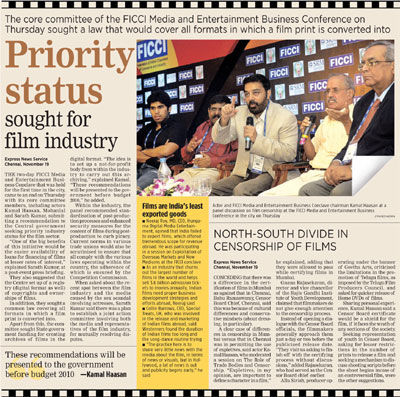| Hyderabad
November 28, 2009

My presentation at the FICCI Frames:
I was presenting at the FICCI Frames MEBC (Media and Entertainment Business Conclave, Chennai) that took place on November 18-19th, 2009. The market leaders of various verticals of the entertainment industry made presentations on their fields. Arvind Ranganathan, CEO Real Image spoke on the digitization of cinema. Kunal Kohli, Rajamouli, Mani Ratnam discussed content. FX Labs & Intel made its presentation on the gaming industry. You get the picture. Other than hearing these people talk, we also get to interact with them in a Q&A session and later during lunches and tea-break.
I had the opportunity to present in the segment “Lobbying for Change: The role of trade bodies & censorship.” It was a priviledge to be on the panel which was moderated by none other than Mr Kamal Haasan himself. The other panelists were R Prasad, Competition Commission of India, Babu Ramaswami, Censor Board Chief, Gnana Rajashekaran, ex Censor Board member. Mr Prasad from the Competition Commission said that the CCI monitor unfair trade practices in businesses in India. They’d then investigate and if required make recommendations to the government to pass laws and decisions that challenge the practices in that specific business. Most of the discussion in the panel was about Censorship in India. It was a really interesting debate, but I am going to skip that. My agenda was to highlight the archaic practices of the Telugu Film Producer’s Council. I was given exactly 6 minutes to speak as there was a shortage of time. My presentation too had only 5 slides. Here, I am going to expand on what I spoke. A majority of my presentation was again was on the restrictive advertising rules of the Telugu Film Producer’s Council (TFPC). I also spoke about the home-video and satellite restrictions.
Also See : CNN-IBN’s clip about FICCI-Frames, where I was featured.
How the Telugu Film Producer’s Council functions:
Before I start off, my father – Allu Arvind was one of the members on the council when the rules that prevail today were formed in the late 1990s. He’s still on board as an executive committee member. In its mission on why the TFPC was formed, it states that to give “equal publicity opportunities to all producers irrespective of their projects and budgets.”[link] The very foundation of the Council is ‘socialism’ or ‘everyone is equal’. The TFPC did a great service to the industry by subsidizing the rates for movie trailers on TV channels. Basically to understand my argument, you should know how the industry functions.
What an “Entertainment Rate”?
The market rates for the 10-second advertisement spot on television, known as TVCs (television commercials) varies between Rs 7,000 to Rs 30,000 on non-news channels like Gemini TV, Teja, Maa TV and ETV. Ideally, a 30 second advertisement would cost a brand anywhere between Rs 20,000 to Rs 50,000. Most of them buy the minutes in bulk on an annual basis. These are the going rates for commercial products such as real estate, soap, mobile phone, TV, insurance and all other ads you see on TV. The rates for a movie trailer in Andhra Pradesh and Bollywood market is usually, a fraction of the commercial rates. This is known as the “entertainment rate”. For ex : A 10 second spot on ETV costs Rs 1965, while on Gemini it costs Rs 2265[link]. This concession is mainly because movie trailers also have ‘entertainment value’ for the channel and of interest to the audience too.
This subsidy would have saved crores of rupees to the industry over the years. Such a subsidy does not exist for tamil films in Tamil Nadu. They pay commercial rates to channels. The TV spend of a big-budget tamil film would be around the Rs 1 crore mark, where a big-budget telugu producer would only spend Rs 20-25 lakh! You might be thinking, whats the problem when everything is so cheap for us?
You cannot customize your campaign:
But, this system also has its pitfalls. A producer cannot go to a channel directly and buy the spots. He has to route it through the TFPC. The Council earns a small commission on the sales of TV spots (fair enough!). But you cannot pick the timing and number of airplays of your trailer gets. The TFPC creates a “playlist” of all the trailers submitted to it, which includes small, big and dubbed films. Each TV channel has specific times (usually non-primetime) when it plays movie trailers. And during those spots, the channel plays the entire trailers given by the Council. All trailers get equal airplay. For ex : If there is 12 minutes of time available for a channel on an evening, and the TFPC has 6 trailers of 30 seconds, each trailer gets played four times. Of course, first preference is given to straight telugu films, dubbed Indian films get second preference and international films get the last preference.
A producer cannot demand for more airplay then what he gets. If he feels his film is not getting the visibility it deserves, he cannot buy more spots. A movie budget made on a budget of Rs 2 crores and a one that’s made with Rs 40 crore should survive with the same resources. If he buys spots directly from the channel and screen trailers, he will be issued with a “non-cooperation” which means he will be banned by the TFPC. A ban means being cut-off from a lot of resources for the Producer. He cannout function in the industry if banned.
Restriction in Print Media:
This restriction is not just for TV, but also print media. You can only issue quarter-page ads in newspapers on five occasions – a Coming soon ad, a day before release, on the day of release, on the 50th day and on the 100th day. If the producer advertises more than that – he will be served a notice by the TFPC and asked to explain on why the rules were violated.
The funny bit is these rules were formed in 1999, when radio advertising, internet, outdoor were not big advertising mediums. So the TPFC does not have any rules pertaining to radio, outdoor, internet and mobile advertising! A producer is free to spend or do whatever on these mediums. Click here to see for yourself on the TFPC’s website.
Andhra Pradesh 1999 v/s 2009:
These rule worked perfectly fine back then. People had only three channels to watch – ETV, Gemini and Teja. Eenadu had near monopoly with Vaartha being a distant second. Andhra Jyothy was not relaunched, while Saakshi and Surya were not born yet. The internet had a very limited presence, unlike today. In 1999, Andhra Pradesh had only 9,38,000 cellphone connections[link]. Today we have over 3,76,00,000 mobile subscribers (2.65 crore GSM link, 1.1 crore CDMA link). To keep it simple, if you advertised on the Sun and Eenadu’s media, you’ve captured almost all of your audience. But, today the audience is totally fragmented. We (a film) have to be present across various mediums to grab their eyeballs. Andhra audiences have nearly 20 channels (entertainment and news) to watch! We have five telugu newspapers (Saakshi, Eenadu, Vaartha, Andhra Jyothy and Surya). Add to that English newspapers (Deccan Chronicle, Times of India, The Hindu and Indian Express). Five radio networks playing telugu music – Radio Mirchi, Radio City, Red FM, Big FM and All-India Radio. Film hoardings dominate the Rs 100 crore, outdoor advertising market in Andhra Pradesh.
The Blockbuster campaign:
To get a blockbuster opening, the movie needs to be present everywhere, constantly reminding the audience that the movie is coming up and encash it at the boxoffice on the opening weekend. But the current restrictions by the TFPC does not allow that, crippling the producer. We cannot create huge buzz just through a few trailer spots and print ads. Even today, inspite of the emergence of newer mediums, TV and print have the biggest share of eye-balls. Andhra Pradesh has nearly a crore homes with TV connections, with about four crore viewers. Between them the top 5 newspapers reach nearly 2.5 crore readers. The producer does not have a free hand in trying to reach these audiences.
Enter – Co-branded advertising:
Today, the cost of advertising has shot up multiple fold. A full page ad in Saakshi or Eenadu can cost upto Rs 40 lakh! A 10-second spot on a top TV program can sell for Rs 35,000! This is where “co-branded advertising” comes in. This is a case, where a brand and movie come together and promote their respective products. The brand could be anything from a mobile phone, bike, beverage to an insurance company. The brand and movie come together create a campaign promoting both products, by creating a ‘connect’ between a brand and the movie. Hollywood pioneered this concept. Bollywood, adapted it well.
Popular co-branded advertisements in Hollywood are that of Sony electronics and James Bond movies, Burger King and Transformer’s co-promotions. Mc Donald’s with Disney and Dreamworks’s animated movies. In India, too popular campaigns were Samsung and Ghajini, Nokia and Om Shanti Om, Pepe Jeans and Dhoom 2. A few images/trailers of popular Hollywood and Bollywood co-branded promotions are present below (at the end of the post). For the 2008 summer blockbuster, Ironman – the four brand partners of the movie – BurgerKing, 7Eleven, Audi and LG Mobile spent over $50 million dollars in promoting the movie[link]. For our movie Ghajini, Tata Indicom, Samsung, Titan, Van Huesen, Tata Sky have spent nearly Rs 10 crores on their co-branded promotions of the movie[link]. We (Geetha Arts), the producers spent another 4 crores on paid advertisement in newspapers, TV channels and radio to create the buzz around our movie. The brand partners that came on board helped us subsidize our costs hugely, yet helped in creating a Rs 14 crore campaign for the movie, which resulted in the movie getting the biggest ever opening for a Hindi film!
Needless to say, the TFPC’s rules do not even recognize “co-branded advertising” as a form of promotion. Any advertisement that uses that film’s imagery of logo is considered a movie ad. Hence, Telugu producers have not been able to attract many brands on being co-branded partners for their movies. Since, advertisement on TV and print is restricted; the collaboration is just restricted to in-store publicity, meet-and-greet and outdoor. This is not of great value to the advertisers. Brand managers and CMOs of many big brands tell me that Andhra Pradesh is a crucial market for them, and that they want to do movie-based promotions as Telugus as the biggest movie buffs in India. But they’re not able to crack deals, as there are many regulatory barriers. If one notices that hoardings in Hyderanbad, you can see while national and global brands pursue big movies, smaller films have been able to attract regional and smaller brands. So, movies of all size can benefit from co-branded advertising.

For ex: For the movie Jalsa, Hyderabad city nearly had 70 hoardings of the movie. Ideally, it would have costed us Rs 50 lakh to run this campaign, considering the hoaring rentals and printing costs. But we were able to do that for a fraction of that cost, as nearly 45 of the hoardings were from our ‘brand partners’ CMR-Chandana Brothers, Big C mobile store and Airtel. Though, our three brand partners were willing to spend on TV spots, print ads – due to the restriction of the TFPC we were not able encash that opportunity.
Bollywood market – An advertiser’s heaven: The Bollywood industry really operates on a ‘free market’ policy. I feel its one of the reasons why it was able to expand rapidly since 2004. There are no barriers to growth through regulation.
In Tamil Nadu and other markets, when a brand has to do a co-branded television promo, they usually buy at regular rates. But for the Hindi/Bollywood market – that’s the not the case. They pay entertainment rates! According to the unofficial rules of the TV industry in Mumbai, if a trailer has 22 seconds of the movie’s visuals it qualifies for an “entertainment rate”. The 22:8 seconds co-branded promotion works really well for advertisers. They’re paying a lower rate for these spots and they’re able to grab eyeballs – as most people switch channels during commercials, but dont when trailers are played. That’s why in Bollywood we see brands tie up even with small and mid-budget movies and run campaigns around them. Through this, the producer too is able to get more TV spots on television, yet not pay the huge monies that are required to do so. Movie-associations are so big in Bollywood, UTV claims in an official press note thatfor one of its films “Dhan Dhana Dhan Goal” it was able to make profits even before its release due to in-film placement from Reebok, Western Union and Gillette (click here to read, PDF file). Now, lets do an analytical study on the publicity restriction of the three major entertainment industries of India :
Bollywood v/s Tamil Cinema v/s Telugu Cinema :
| Publicity Medium |
Bollywood |
Tamil Cinema |
Telugu Cinema |
| Television |
- Subsidy on television advertising. No restriction on amount spend.
- Co-branded ads also given ‘entertainment rates’.
|
- No subsidy to movie advertising.
- Co-branded TVCs allowed, but at full rates.
|
- Subsidized television rates, restriction on TV spend.
- ‘Co-branded TVCs’ not allowed even if advertiser is willing to pay full rate
|
| Print |
- No subsidy.
- No restriction
- Co-branded promos allowed.
|
- No subsidy in rates.
- But restriction on size, number of paid ads by producer.
- No restrictions on co-branded promotions.
|
- No subsidy.
- Restrictions on size, number of paid ads.
- Co-branded ads not allowed.
|
From the above table it can be understood that, in terms of rules the TFPC has the most restrictive and archaic rules. While the tamil industry doesn’t have subsidies – it isn’t too restrictive either. Bollywood (or Hindi cinema) has best of the both worlds – subsidies and no restrictions. One of the reasons cited by the TFPC for these rules is that its trying to keep the producer’s publicity costs in check, without them overspending? That’s lame. Marketing, today is a fraction of the movie. We still spend the biggest part of the movie’s budgets on remunerations of artistes and directors. Also the fad of shooting for 100s of days. The same TFPC couldn’t impose a restriction on remunerations and budgets of the movie (which the Malayalam Producer’s Council did)[link]. Ask anybody in the film business – they’d tell its the talent’s remunerations that have made movies less profitable, and more risky. For a big telugu film, anywhere 40-60% of the movie is spent on remunerations. That is why most of our big films cost over Rs 20 crores to make – but we never see that money on screen. Marketing hardly costs us 5-7% of our budgets. Our industry has grown by so much, we can afford that little extra that goes into marketing a film.
Read the complete article at Allu Sirish's blog
Other articles by Allu Sirish:
Corporatization of the telugu film industry: How to adapt Hollywood’s “studio model” locally
Small budget Telugu films
Movie Marketing or the lack of it in telugu cinema
 |
About Allu Sirish: Sirish Allu is a 21 year old blogger from Hyderabad, India. He has completed Bachelors in Mass Media (Journalism) in R.D National College, Mumbai. He is a hardcore movie buff. Sirish Allu has been associated in the production of Geeta Arts films like Jalsa and Ghijini (Aamir Khan). Sirish Allu is the co-producer of Aamir Khan's Ghajini.
You can visit Allu Sirish blogs at http://www.allusirish.in/ |
|

